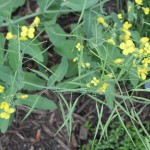New garden beds are in the future at Johnson Park Elementary School. The long-cherished garden beds, sheltered from deer by their location in the courtyard, are showing their age.
Edible Gardens & Environment
PSGC began its work on food systems literacy by funding, establishing and maintaining Edible Gardens at all six schools in the Princeton Public Schools district. Our next step was to fund Edible Gardens stewards/instructors to make each garden unique to its students and to foster curricular connections and to connect children to the natural systems that support all life.
Select a school from the drop-down menu to see edible garden activity there.
Garden beds in storage during construction
Repairs and renovations put the Edible Gardens at Princeton High School in a construction pathway, so several of the raised garden beds were put into storage. There are two raised beds/boxes that Principal Jessica Baxter calls the Memorial Gardens, on the west side of the school. Topsoil, taken from the garden area, is there as well. The area outside the English office is planted with edibles and is near a water supply.
Ravishing radishes in school gardens
 During May, 2015, the Garden State on Your Plate program of the Princeton School Gardens Cooperative hosted radish tastings on Wednesdays in the four elementary schools. Since I am the school garden educator for two of those schools, I had the chance for some garden serendipity, tying in our school garden radishes to the radishes being experienced in the cafeteria.
During May, 2015, the Garden State on Your Plate program of the Princeton School Gardens Cooperative hosted radish tastings on Wednesdays in the four elementary schools. Since I am the school garden educator for two of those schools, I had the chance for some garden serendipity, tying in our school garden radishes to the radishes being experienced in the cafeteria.
It began with an email from Fran McManus with an idea for planting radish seeds in transparent containers, which would allow students to observe the development of both the root—the radish—and the leaves. My sister had donated a bunch of transparent plastic gelato containers, so I had Community Park School third graders fill them with potting mix, then carefully plant radish seeds adjacent to the outer walls, so we could watch them grow. As an added bonus, we planted half purchased seeds, and the other half were seeds saved by Kindergartners from the Community Park garden itself, to see which would grow better.
By the time we planted the radishes in the jars, there were already Kindergarten radishes coming along nicely in one of the Community Park beds.
I checked both the jarred radishes and the garden bed radishes a couple days before the tasting. The jarred radishes showed nary a sign of any radish root development, just some disappointing white roots. The gardened radishes were reaching the point of woodiness, but they were lovely on the outside, and some were developing flowers, which, I knew from talking with Charlie Thomforde, the wonderful Trent House gardener, would soon turn into sweet little radish pods, tasty if we got to them before they fully went to seed.
So, on radish tasting day, all the Kindergartners met out in the garden to pick three radishes, one for each class to present to Joel Rosa, Nutri-Serve food service director for PPS. Why only three? I explained to the kids that I wanted the rest to go to pods, which we could pick.
He was wonderful with the kids, and was duly impressed when he learned that we were planning to eat radish pods soon.
A week or so later, radish tasting came to Littlebrook School, my other K-5 school. I was so excited on that day to discover that our forage radishes, which fourth graders had planted as part of a cover crop mix (more on that another time) were going to lovely delicate pods.
All three fourth grade teachers responded enthusiastically to my request to bring their classes out for a brief picking and tasting of pods.
I asked the students to answer three questions:
- Did the pods taste like the radishes they had tasted earlier that day in the cafeteria?
- If so (or even if not), were the pods milder or spicier than the radishes they had already tasted?
- If not like radishes, what did the pods taste like?
Very few students—or I, for that matter—actually thought the pods tasted like radishes. Everyone thought they were milder. Many students thought the pod tasted like a mini green bean or a pea pod. I can’t remember all the other answers.
The garden is nothing if not a place for serendipity!
